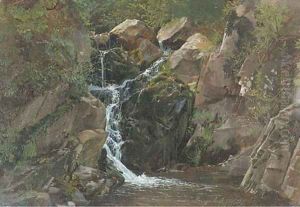Attibuted To Carl Dahl Paintings
Carl Dahl, also known as Johan Carl Dahl, was a 19th-century Norwegian landscape painter born in Oslo, Norway, then known as Christiania. He was born on February 24, 1812, into a family that appreciated the arts, which likely influenced his future career. Not to be confused with the more famous Danish landscape painter Johan Christian Dahl, Carl Dahl’s work and life are less documented and remain somewhat obscure in comparison.
Carl Dahl’s artistic journey began in his native Norway where he developed an interest in landscape painting, a genre that was becoming increasingly popular during that period. He was part of the Düsseldorf school of painting, a group that had a significant impact on the art of the time and was known for its rigorous approach to the naturalistic representation of landscapes. The Düsseldorf school emphasized detail, composition, and atmospheric effects, all of which can be seen in Dahl's work.
Despite the lack of extensive records of his life, Carl Dahl’s paintings suggest that he was an accomplished artist of his time. His landscapes typically feature Norwegian scenery, with attention to the changing qualities of light and atmosphere. He depicted the grandeur of Norway's mountains, fjords, and coastal regions with a romantic sensibility that was common among landscape artists of that era.
Dahl’s career spanned a period of significant change in European art, as the Romantic movement gave way to Realism and then Impressionism. Despite these shifts, he maintained a consistent style throughout his career, focusing on the natural beauty of his homeland. His works were likely exhibited in Norway and possibly in other European countries, contributing to the era's appreciation of the natural world through art.
Carl Dahl passed away on October 7, 1865. While his legacy may not be as prominent as some of his contemporaries, his contributions to the field of landscape painting are part of the rich tapestry of 19th-century European art. His paintings are appreciated by collectors and art historians who have an interest in the Düsseldorf school and in Norwegian landscape art of the period. Today, his works can be found in art museums in Norway and might appear in international auctions where 19th-century European art is appreciated.
